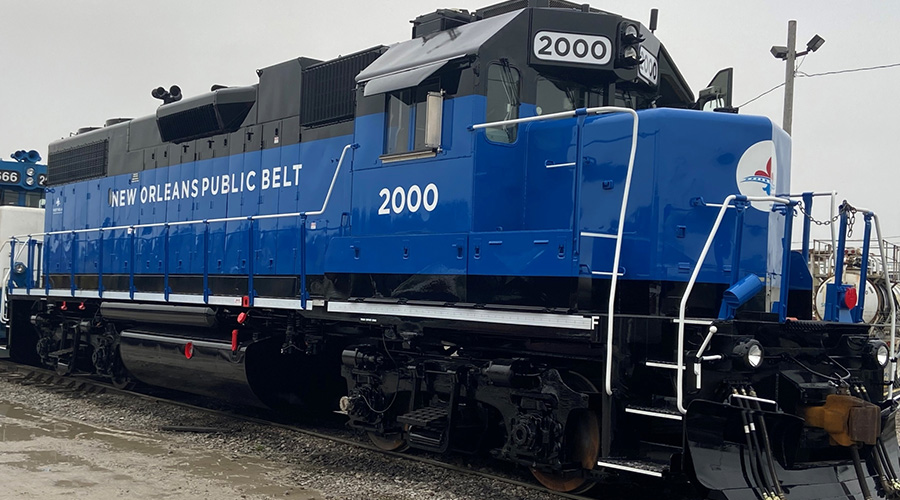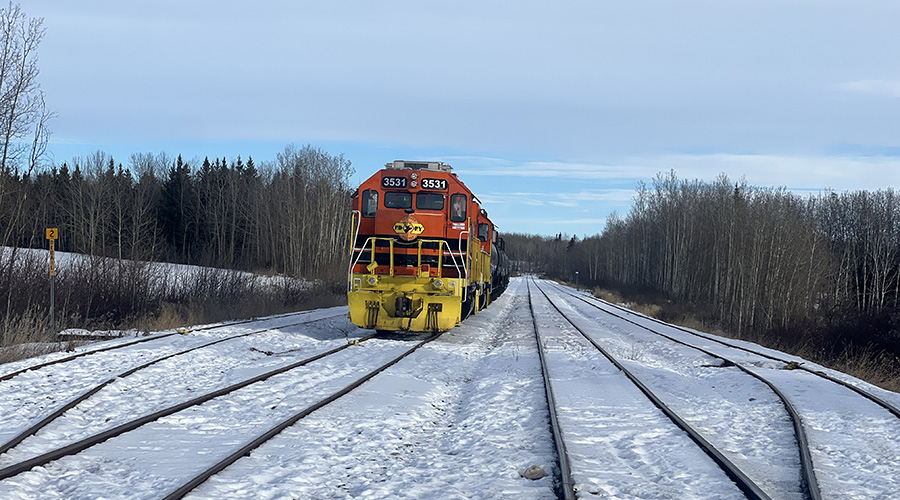Short-line traffic mostly sluggish in Q2, first half
7/30/2024
By Jeff Stagl, Managing Editor
When it comes to periods of traffic growth, the year’s first half didn’t qualify as one for short lines. The collective carloads for 458 short lines totaled 3,072,718 through 26 weeks, down 3.9% year over year, according to the RailConnect Index of Short Line Traffic compiled by GE Transportation/Wabtec for the period ending June 29.
Traffic in three of 14 commodity groups fell by double-digit percentages: coal at 15.3% to 119,524 units; petroleum and coke at 12.4% to 107,784 units; and farm and food products excluding grain at 10% to 145,294 units.
In addition, chemical loads declined 9.5% to 576,901 units; “all other” carloads dropped 8.4% to 49,680 units; stone, clay and aggregates traffic decreased 6.9% to 342,634 units; and paper product loads dipped 5.8% to 154,905 units.
Traffic increased in only three commodity groups, led by intermodal at 12.5% to 503,396 units. Motor vehicles and equipment loads climbed 4.7% to 102,871 and ores carloads rose 3.5% to 85,858.
RailPrime reached out to a number of regionals, short lines and holding companies to find out how their traffic fared in the second quarter and first half. Emailed responses from 10 of them follow.
 One traffic bright spot for the 75-mile short line in New Orleans: intermodal. In the first half, container volume climbed 15% year over year. New Orleans Public Belt Railroad
One traffic bright spot for the 75-mile short line in New Orleans: intermodal. In the first half, container volume climbed 15% year over year. New Orleans Public Belt RailroadWatco: Coal’s big jump a big surprise
Watco’s traffic in the first half dipped 1% year over year. The holding company — which owns 46 short lines — registered similar results in Q2, when carloads declined 0.5%.
Despite an overall carload drop, coal traffic was a big gainer in the first half, jumping 42% year over year.
“We knew we’d see an increase, but were surprised that it was that much,” said Watco Senior Vice President of Rail Operations Jimmy Patterson. “However, the coal gain was offset by a decrease in frac sand (-28%) and metals (-12%).”
A North Carolina paper mill that shut down in Q2 2023 caused one short line’s total volume to tumble nearly 50% in Q2.
“Not a surprise, but a big reason we were relatively flat year over year,” said Patterson.
Watco projects coal volume to remain strong going forward. Agricultural products traffic has increased 4%, but hasn’t been as strong as expected, said Patterson.
“We expected a bigger rebound coming off of last year’s drought in Kansas. With that said, timely rains have us optimistic for the fall crops in the Central Plains to make a positive impact towards the end of Q3,” he said.
Meanwhile, traffic has been quite the slog for the New Orleans Public Belt Railroad Co. (NOPB) in 2024. Freight volume fell 17% and 19% in Q2 and the first half, respectively.
“West Coast carriers had issues due to flooding between Houston and New Orleans, which contributed to a decrease in [our] traffic,” NOPB officials said.
One bright spot for the 75-mile short line — which interchanges with all the Class Is — is container traffic, which climbed 15% in the half.
“Through its growing intermodal service and efficient global and inland connections, the Port of New Orleans ensures that goods arrive at homes across the nation, that businesses can efficiently move their products, and that economic prosperity and job creation for the state of Louisiana and region continues,” NOPB officials said.
 Although the Pennsylvania regional’s anthracite coal traffic jumped more than 20% in the first half, its frac sand carloads tumbled 40% in the same period. Reading, Blue Mountain & Northern Railroad
Although the Pennsylvania regional’s anthracite coal traffic jumped more than 20% in the first half, its frac sand carloads tumbled 40% in the same period. Reading, Blue Mountain & Northern RailroadNot what IHB had in mind
For the more than 300-mile Indiana Harbor Belt Railroad Co. (IHB), first-half traffic dipped 1%.
“We did think our volume would grow year over year, but this so far is not the case,” said IHB General Manager John Wright.
There were some unplanned plant shutdowns that impacted the short line’s traffic.
“There were shutdowns with refining, steel and food grade. We hit it all this year,” said Wright.
Traffic hasn’t been that bad, but hasn’t been great, either, for the more than 100-mile Chicago South Shore & South Bend Railroad (CSS). Q2 traffic was flat, said CSS President Todd Bjornstad.
“We are slightly behind at the mid-year point due to unplanned outages for a coal customer,” he said. “[But] metals and food products are performing well.”
Merchandise traffic also was basically flat for the 400-mile Reading, Blue Mountain & Northern Railroad Co. (RBMN) in the half. Nonetheless, anthracite coal business soared more than 20%.
“But our frac sand business continues to suffer along with everyone else in our region, with it being down 40%,” said RBMN President Wayne Michel.
Q2 volume rose slightly for Genesee & Wyoming Inc., which owns more than 100 regionals and short lines in Canada and the United States. The holding company was able to post a small gain despite weakness in coal, minerals and stone, and metals traffic.
OmniTRAX: Similar stories in Q2, 1H
Q2 traffic was slightly more encouraging for OmniTRAX Inc., increasing by a low single-digit percentage. The owner of more than 20 regionals and short lines noted traffic strength in minerals, metals, grains and chemicals, which more than offset a traffic decline in energy products.
“It was a similar story in the first half. Year to date, we’re about flat, with energy market declines offsetting gains in the same categories [from Q2],” said OmniTRAX Senior VP of Commercial Operations Brian Ward. “The increase in local sand utilization for drilling is the primary negative driver, but with balanced increases across commodity groups, we are optimistic for the second half of the year.”
Conversely, traffic was quite strong for the Red River Valley & Western Railroad (RRVW) and Twin Cities & Western Railroad (TCWR). The sister railroads operate in North and South Dakota, and Minnesota.
Carloads for the 500-mile RRVW jumped 18% year over year in both Q2 and the first half. Grain carloads skyrocketed 37% in the first half, driven by steady export corn demand.
“I should note that 2023 grain carloads were incredibly soft on RRVW and the 2024 year-to-date volumes represent more normalized activity,” said Victor Meyers, who serves as president of both RRVW and TCWR.
In addition, the regional’s high-fructose corn syrup carloads soared 23% in the first half because of increased demand for the sweetener in the United States.
 The owner of more than 20 regionals and short lines, OmniTRAX noted Q2 traffic strength in minerals, metals, grains and chemicals, which more than offset an energy products traffic decline. OmniTRAX Inc.
The owner of more than 20 regionals and short lines, OmniTRAX noted Q2 traffic strength in minerals, metals, grains and chemicals, which more than offset an energy products traffic decline. OmniTRAX Inc.Grain a gainer for TCWR
For the 360-mile TCWR, carloads rose 5% in Q2 and 4% in the first half. Grain carloads increased 5% in the half for Minnesota’s largest short line.
“TCWR is not seeing as much export demand as RRVW, but TCWR customers are loading domestic shuttles in which demand has remained steady,” said Meyers.
Also in the half, the short line’s ethanol carloads climbed 17% due to customers’ increased ethanol production and sugar carloads shot up 31% because of strong regional production and strong U.S. demand.
Sierra Northern Railway had a strong quarter, too. Its traffic rose 6% in Q2.
“Most of the growth can be attributed to container movements at our Oakdale Inland Port operation,” said Kennan Beard, the northern California short line’s president and CEO.


